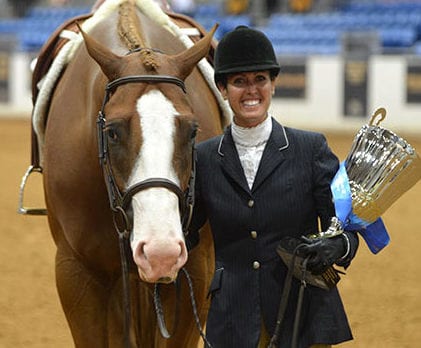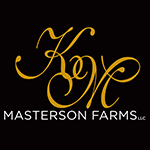Imagine horse show folks rapt in speculative chatter with fellow competitors, moralizing the way people ride and show their horses, concerned with state of the industry, its prospects for growth and the direction it is taking. Imagine cowboys – trainers, riders and owners exchanging ideas along dusty rails, meeting in tack rooms to contemplate the merits of one idea over another while dreaming up a better future for show horses.
Then imagine a few good men, tired of complaining on the sidelines, decide to take a giant leap forward to do something special for the horse. In it for the long haul, they throw caution to the wind and meet in Dallas, Texas to hammer out the details. What followed, their creation, is the National Snaffle Bit Association.
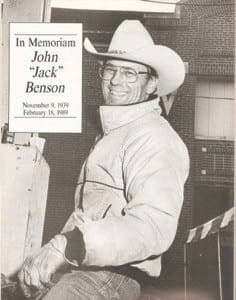 The founders started by gathering donations from those most active in the industry – the trainers, riders and owners who would be most affected by a change – or worse – a lack of change. Using the funds gathered one hundred dollars at a time as seed money; the NSBA was founded in 1983.
The founders started by gathering donations from those most active in the industry – the trainers, riders and owners who would be most affected by a change – or worse – a lack of change. Using the funds gathered one hundred dollars at a time as seed money; the NSBA was founded in 1983.
There were many who can rightfully take credit for getting the Association off the ground. But a few were especially crucial to making it happen – Leo Barbera, Walter Hughes, Jerry Stanford and Jack Benson (pictured right) amongst them. Intent on promoting kinder training methods, truer gaits and longevity in show horses, these cowboys strove to protect the horse and ensure a strong future for the show horse.
The legendary cowboys, many who we still see in the show pen today, were tired of seeing the two-year olds pushed so hard to perform, troping around the show pen. They wanted to create a venue that encouraged trainers to take more time with their young stock, a platform that showcased trainers doing right by their horses, something that provided longer show careers for the horses.
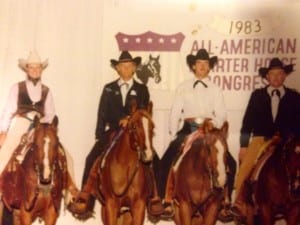 To do this, trainers had to stop pressuring the two-year olds to have them ready to show in bridles in June or July. At the time, two-year old futurity horses, where earnings were the biggest, were shown in long shanked bits and expected to perform as their elder cousins would. Specifically, these horsemen wanted to see two-year olds shown in snaffle bits – with light contact, no less. (Pictured second to the left, Jerry Stanford. All four horses pictured were by legendary western pleasure sire, The Invester)
To do this, trainers had to stop pressuring the two-year olds to have them ready to show in bridles in June or July. At the time, two-year old futurity horses, where earnings were the biggest, were shown in long shanked bits and expected to perform as their elder cousins would. Specifically, these horsemen wanted to see two-year olds shown in snaffle bits – with light contact, no less. (Pictured second to the left, Jerry Stanford. All four horses pictured were by legendary western pleasure sire, The Invester)
“We first formed the National Pleasure Horse Association but it didn’t quite have the leadership that was needed to get off the ground,” says trainer and judge Brad Gibby, who was there from the very beginning when NSBA was formed. “That’s when we came together again and our vision for NSBA was for it to be a place to market our western pleasure horses and for us to slow down a bit and not push the horses as much as we had in the past.”
During the formation of NSBA, AQHA trainer and judge Mike Carter (pictured above left–far right) was one of the top western pleasure trainers in the industry. “When we first switched from the big bits to snaffle bits, it got pretty ‘western’ for a few years,” Carter recalls and laughs. “Back then, the horses didn’t have a leg yield and I remember people being lined up for Tom Chown to tie our hackamore because none of us knew how to do it. It was quite a shock to change from the bigger bits to a snaffle.”
Gibby agrees, “We had to hold on pretty tight in the beginning. The horses were not dictated to every stride like they are now and I would say they were a lot more forward moving.”
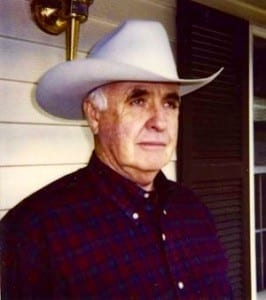 Over time, big moneyed pleasure futurities became synonymous with NSBA. Breeders, trainers and owners all benefited from the prestige of winning at NSBA events. (Walter Hughes–pictured right)
Over time, big moneyed pleasure futurities became synonymous with NSBA. Breeders, trainers and owners all benefited from the prestige of winning at NSBA events. (Walter Hughes–pictured right)
Tom Powers, who just celebrated the 35th anniversary of his futurity, says that he has seen NSBA dramatically grow over the years. “I first saw it as a place to put less pressure on the younger horses, but due to the increase of payouts in the two and three year-old classes, I saw the pressure increasing again on the young horses. However, now I see it coming full circle again where NSBA and AQHA are trying to get back to where the welfare of the horse is paramount.”
Over the years, NSBA’s board of directors has always come from the field of horsemen who worked or played in the show pen. Board members poured their passion for the horse and the horse industry into the association and NSBA grew. But in the beginning, it was only a western pleasure based organization. That is until NSBA welcomed a new board member, June Warren. June spoke for the hunter under saddle horse and before long she had lassoed the cowboys and a hunter under saddle division was established. For every addition on the western side, June Warren made sure a commensurate addition was made for the hunter horses.
This historic addition in 1986 started explosive growth for the National Snaffle Bit Association, but it served another, perhaps more important. purpose: it brought the importance of diversity front and center to NSBA.
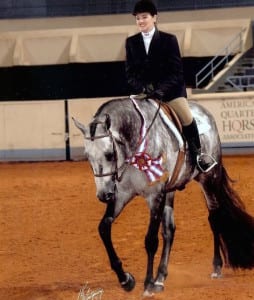 Diversification: With June Warren’s (pictured left) addition of the hunter under saddle division, NSBA now offered a place where both Western and English prospects were rewarded. As new board members replaced the original cast, fresh ideas and new classes such as yearling longe line were crafted. NSBA created a limited rider’s list, formulated standards for judging, began to allow the use of hackamores and started auctioning off training services to provide a crisis fund for trainers.
Diversification: With June Warren’s (pictured left) addition of the hunter under saddle division, NSBA now offered a place where both Western and English prospects were rewarded. As new board members replaced the original cast, fresh ideas and new classes such as yearling longe line were crafted. NSBA created a limited rider’s list, formulated standards for judging, began to allow the use of hackamores and started auctioning off training services to provide a crisis fund for trainers.
From its humble beginnings, the NSBA has always been a member driven association. Founded on money from the pockets of horse trainers, owners and riders across the country, the NSBA has always gone directly to its membership for authority. Board members are still owners, trainers and riders – those very people actively involved in showing and promoting show horses.
The board developed breeding incentive programs with the Stallion Incentive Fund (SIF) to reward both the breeder and the offspring who went to the show pen. As the acting representative for the breeder of pleasure and hunter under saddle horses, an event that highlighted the horses bought, sold and bred through NSBA was inevitable. With that the Breeders Championship Futurity (BCF) was born.
NSBA’s growth was not always straight up. Like any young association, there were ups and downs. But once again a board member would breath new life into the NSBA. This time, the board member came from the pool of non-professional riders.
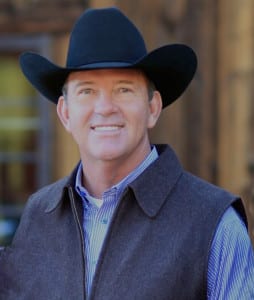 Ken Banks came on board and brought more than fresh ideas and a sharp pencil to NSBA. He brought business acumen to the organization at the precise moment they needed it. With boldness, he added financial structure and accountability to every program and department. He even brought his own employees.
Ken Banks came on board and brought more than fresh ideas and a sharp pencil to NSBA. He brought business acumen to the organization at the precise moment they needed it. With boldness, he added financial structure and accountability to every program and department. He even brought his own employees.
Banks spent countless hours at what Banks does best when he is not showing his horses – deconstructing and reconstructing financial statements. And working hand in hand with Ken through the reconstructive process was Dianne Eppers.
Involved with the Association almost from its inception, Dianne started with NSBA first as a horse trainer and board member, before being hired as a consultant. After five years serving as a consultant, NSBA named Dianne as Executive Director. The Association has seen incredible changes in her tenure and there is no sign of the engine slowing down.
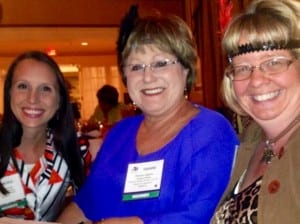 Since coming on board, Dianne (pictured left – middle) has worked closely with board members to implement new programs that make use of the foundation found in well-trained rail horses. The original intent of the founding fathers was proving successful and horses were being shown well into their teenage years.
Since coming on board, Dianne (pictured left – middle) has worked closely with board members to implement new programs that make use of the foundation found in well-trained rail horses. The original intent of the founding fathers was proving successful and horses were being shown well into their teenage years.
Young futurity winners were going on to have success in other areas. They became stars in the horsemanship, the western riding, trail and working hunter. The system was working and horses were providing years of fulfillment to riders across disciplines.
Trainers began asking for more NSBA classes for their riders who did not own or show futurity horses. Many of the early supporters did not want to see the addition of other classes. But eventually “they saw the potential for growth for the Association,” said NSBA Past President Leslie Lange.
 Riders showing in other events provided a different market for futurity horses as prospective all-around horses. The crossover was inevitable and has been hugely successful for NSBA. Leslie indicated it was during this time that NSBA expanded the Breeders Championship Futurity, added trail and western riding to the roster and the show transitioned to the NSBA World Championship Show.
Riders showing in other events provided a different market for futurity horses as prospective all-around horses. The crossover was inevitable and has been hugely successful for NSBA. Leslie indicated it was during this time that NSBA expanded the Breeders Championship Futurity, added trail and western riding to the roster and the show transitioned to the NSBA World Championship Show.
Dual approval introduced a method for riders to qualify by showing in front of a certain number of judges prior to the qualifying deadline. Smart points gave kids an opportunity to earn scholarships for youth riders. The last decade, one innovative program after another has spawned 20 percent growth rates in the Association.
This year’s show will pay out over $650,000 in prize money. Horses sold through last year’s sale will ride for an additional $92,000 in earnings this year. The sale is a unique concept that allows owners to choose whether they want to ride for the additional money in the horse’s two-year old or three-year old year.
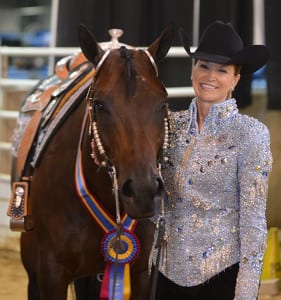 Last year’s sale horse graduates who ride for a separate purse, have largely postponed their declared year to show until the three-year old year. Sale Chairman Allen Mitchels feels the high percentage of horses being held back is another indicator that NSBA’s original philosophy is working.
Last year’s sale horse graduates who ride for a separate purse, have largely postponed their declared year to show until the three-year old year. Sale Chairman Allen Mitchels feels the high percentage of horses being held back is another indicator that NSBA’s original philosophy is working.
There is no single move that explains NSBA’s success. Rather it is the combination of great moves and great people passionate about promoting good training methods, venues to highlight effective breeding programs and protecting the future of show horses. Together these horsemen work to create success for NSBA members. Just like training great horses – the foundation for success is laid early and over the course of time. Today that foundation is working.


